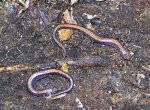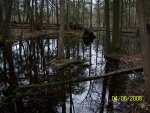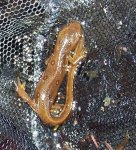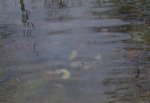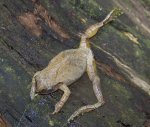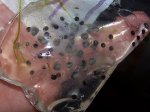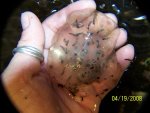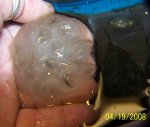- Joined
- Dec 13, 2006
- Messages
- 6,624
- Reaction score
- 120
- Points
- 63
- Location
- Wappingers Falls, NY
- Country
- United States
Today my boyfriend and I went to some vernal pools in Ulster County, NY.
We saw some redbacks under logs, and in one of the pools we saw Noto. viridescens.
We also saw eggs that we can't identify, maybe someone has a clue.
The pics:
1. P. cinereus under a log
2. The vernal pool with the Notos
3. A Noto. Many of them looked kind of reddish like this, I'm thinking they weren't very old. Maybe their first reproductive year.
4. The egg masses, viewed through the water
5. One of the egg masses close up. I had to put it on the log because my bf wouldn't hold it for me to photograph. It was rubbery and floppy.
6. A dead frog that was floating in the water, I put it on the log to photograph. There was a lot of peeping going on, not too far off from where we were.
And a year and a half ago I couldn't even touch a worm.
7. A different type of egg we saw
8. Another Noto, obviously male. This one was darker than most of them, so I thought it was a bit older.
This is my first field herping report so if I left out certain info I'll add it. It was a forested area, not far from the Hudson River, and we had to hike up a big hill (not really a mountain) to get there.
I carried all my equipment in my caudata.org bag!
We saw some redbacks under logs, and in one of the pools we saw Noto. viridescens.
We also saw eggs that we can't identify, maybe someone has a clue.
The pics:
1. P. cinereus under a log
2. The vernal pool with the Notos
3. A Noto. Many of them looked kind of reddish like this, I'm thinking they weren't very old. Maybe their first reproductive year.
4. The egg masses, viewed through the water
5. One of the egg masses close up. I had to put it on the log because my bf wouldn't hold it for me to photograph. It was rubbery and floppy.
6. A dead frog that was floating in the water, I put it on the log to photograph. There was a lot of peeping going on, not too far off from where we were.
And a year and a half ago I couldn't even touch a worm.
7. A different type of egg we saw
8. Another Noto, obviously male. This one was darker than most of them, so I thought it was a bit older.
This is my first field herping report so if I left out certain info I'll add it. It was a forested area, not far from the Hudson River, and we had to hike up a big hill (not really a mountain) to get there.
I carried all my equipment in my caudata.org bag!

